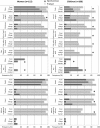Local concepts of anemia-related illnesses and public health implications in the Taabo health demographic surveillance system, Côte d'Ivoire
- PMID: 24499516
- PMCID: PMC3816622
- DOI: 10.1186/2052-1839-13-5
Local concepts of anemia-related illnesses and public health implications in the Taabo health demographic surveillance system, Côte d'Ivoire
Abstract
Background: A 14-month prospective longitudinal study conducted in the Taabo health demographic surveillance system (HDSS), south-central Côte d'Ivoire, revealed high prevalence of anemia in different population groups in three types of settings (i.e., small town, village, and hamlet). Demographic parameters and several variables related to parasitic infections, micronutrient status, and inflammation were significantly associated with higher odds of anemia. However, cultural concepts and knowledge of various anemia-related illnesses and their relation with people's behaviors have not been investigated.
Methods: Sixteen focus group discussions and six key informant interviews were performed with village authorities, health workers, and traditional healers. Questionnaires were administrated to 200 school-aged children and 115 young women. Of these individuals, 206 participated in the preceding longitudinal study, whereas the remaining 109 people were not exposed to prior research, but had similar age and sex profiles. Mean prominence of participants' responses was compared between groups of participants and across study settings.
Results: Local concepts of anemia-related illnesses referred to its perceived causes based on two logical frameworks - biomedical and sociocultural - although a clear distinction was often blurred. We found few differences in knowledge, beliefs, and behaviors across study settings and between participants who were exposed to prior research and newly recruited ones. Malaria und nutritional issues as understood and managed by the population differed from definitions and recommendations provided by the health system. Malaria was not acknowledged as an exclusive mosquito-transmitted disease and participants referred to the quantity, rather than the quality, of food when talking about nutritional issues.
Conclusions: Local concepts and ideas about anemia have public health implications, inasmuch as they are related to people's attitudes, risk-related and help-seeking behaviors, which in turn might affect their health status. Local terminology and beliefs about anemia and malaria should be carefully considered when developing health intervention and education programs. The similarity in knowledge about anemia-related illnesses and associated behaviors, regardless of study setting and prior exposure to research, suggests that a uniform communication strategy may be used to develop education programs and awareness campaigns aimed at the prevention and control of anemia in south-central Côte d'Ivoire.
Figures


Similar articles
-
Côte d'Ivoire Dual Burden of Disease (CoDuBu): Study Protocol to Investigate the Co-occurrence of Chronic Infections and Noncommunicable Diseases in Rural Settings of Epidemiological Transition.JMIR Res Protoc. 2017 Oct 27;6(10):e210. doi: 10.2196/resprot.8599. JMIR Res Protoc. 2017. PMID: 29079553 Free PMC article.
-
Health & Demographic Surveillance System Profile: The Taabo Health and Demographic Surveillance System, Côte d'Ivoire.Int J Epidemiol. 2015 Feb;44(1):87-97. doi: 10.1093/ije/dyu221. Epub 2014 Nov 29. Int J Epidemiol. 2015. PMID: 25433704
-
Dynamics of anemia in relation to parasitic infections, micronutrient status, and increasing age in South-Central Côte d'Ivoire.J Infect Dis. 2013 May 15;207(10):1604-15. doi: 10.1093/infdis/jit066. Epub 2013 Feb 18. J Infect Dis. 2013. PMID: 23420905
-
Pregnancy-related morbidity and risk factors for fatal foetal outcomes in the Taabo health and demographic surveillance system, Côte d'Ivoire.BMC Pregnancy Childbirth. 2018 Jun 7;18(1):216. doi: 10.1186/s12884-018-1858-2. BMC Pregnancy Childbirth. 2018. PMID: 29879939 Free PMC article.
-
Use of Insecticides in Agriculture and the Prevention of Vector-Borne Diseases: Population Knowledge, Attitudes, Practices and Beliefs in Elibou, South Côte d'Ivoire.Trop Med Infect Dis. 2020 Mar 1;5(1):36. doi: 10.3390/tropicalmed5010036. Trop Med Infect Dis. 2020. PMID: 32121510 Free PMC article.
Cited by
-
HIV/AIDS-related mortality in Africa and Asia: evidence from INDEPTH health and demographic surveillance system sites.Glob Health Action. 2014 Oct 29;7:25370. doi: 10.3402/gha.v7.25370. eCollection 2014. Glob Health Action. 2014. PMID: 25377330 Free PMC article.
-
"Satanism is witchcraft's younger sibling": Changing perceptions of natural and supernatural anaemia causality in Malawian children.PLoS One. 2021 Apr 30;16(4):e0250661. doi: 10.1371/journal.pone.0250661. eCollection 2021. PLoS One. 2021. PMID: 33930023 Free PMC article.
-
Adult non-communicable disease mortality in Africa and Asia: evidence from INDEPTH Health and Demographic Surveillance System sites.Glob Health Action. 2014 Oct 29;7:25365. doi: 10.3402/gha.v7.25365. eCollection 2014. Glob Health Action. 2014. PMID: 25377326 Free PMC article.
-
Côte d'Ivoire Dual Burden of Disease (CoDuBu): Study Protocol to Investigate the Co-occurrence of Chronic Infections and Noncommunicable Diseases in Rural Settings of Epidemiological Transition.JMIR Res Protoc. 2017 Oct 27;6(10):e210. doi: 10.2196/resprot.8599. JMIR Res Protoc. 2017. PMID: 29079553 Free PMC article.
-
Perceptions and beliefs about anaemia: A qualitative study in three agroecological regions of Ghana.Matern Child Nutr. 2021 Oct;17(4):e13181. doi: 10.1111/mcn.13181. Epub 2021 Mar 29. Matern Child Nutr. 2021. PMID: 33780144 Free PMC article.
References
-
- McLean E, Cogswell M, Egli I, Wojdyla D, de Benoist B. Worldwide prevalence of anaemia, WHO vitamin and mineral nutrition information system, 1993–2005. Public Health Nutr. 2009;12(4):444–454. - PubMed
-
- WHO. Turning the tide of malnutrition: responding to the challenge of the 21st century. Geneva: World Health Organization; 2000. WHO/NHD.007.
-
- Tolentino K, Friedman JF. An update on anemia in less developed countries. Am J Trop Med Hyg. 2007;77(1):44–51. - PubMed
-
- Crawley J. Reducing the burden of anemia in infants and young children in malaria-endemic countries of Africa: from evidence to action. Am J Trop Med Hyg. 2004;71(2 Suppl):25–34. - PubMed
LinkOut - more resources
Full Text Sources
Other Literature Sources

